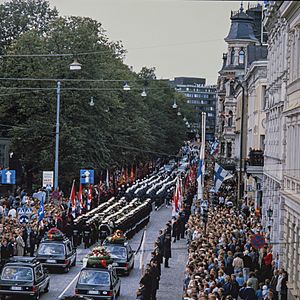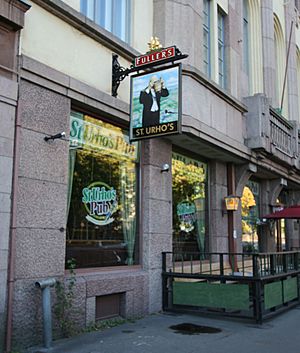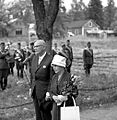Urho Kekkonen facts for kids
Quick facts for kids
Urho Kekkonen
|
|
|---|---|
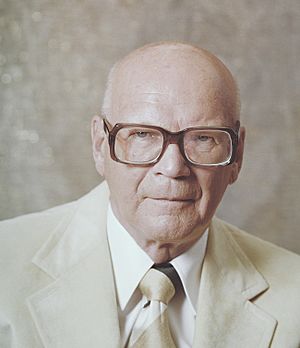
Urho Kekkonen in 1977
|
|
| 8th President of Finland | |
| In office 1 March 1956 – 27 January 1982 |
|
| Prime Minister |
List
Karl-August Fagerholm
V. J. Sukselainen Rainer von Fieandt Reino Kuuskoski Martti Miettunen Ahti Karjalainen Johannes Virolainen Rafael Paasio Mauno Koivisto Teuvo Aura Kalevi Sorsa Keijo Liinamaa |
| Preceded by | J. K. Paasikivi |
| Succeeded by | Mauno Koivisto |
| Prime Minister of Finland | |
| In office 20 October 1954 – 3 March 1956 |
|
| President | J. K. Paasikivi |
| Preceded by | Ralf Törngren |
| Succeeded by | Karl-August Fagerholm |
| In office 17 March 1950 – 17 November 1953 |
|
| President | J. K. Paasikivi |
| Preceded by | Karl-August Fagerholm |
| Succeeded by | Sakari Tuomioja |
| Personal details | |
| Born | 3 September 1900 Pielavesi, Grand Duchy of Finland, Russian Empire |
| Died | 31 August 1986 (aged 85) Helsinki, Finland |
| Political party | Agrarian League (1933–1965) Centre Party (1965–1982) |
| Spouse | Sylvi Kekkonen |
| Children | Matti, Taneli |
| Residence | Tamminiemi |
| Alma mater | University of Helsinki |
| Profession | Lawyer, police officer, journalist |
| Signature | |
Urho Kaleva Kekkonen (3 September 1900 – 31 August 1986), often called UKK, was a Finnish politician. He was the eighth and longest-serving President of Finland, from 1956 to 1982. He also served as prime minister from 1950 to 1953 and again from 1954 to 1956. He held many other important jobs in the government too. He was the third president from the Agrarian League/Centre Party. He was the head of Finland for almost 26 years. Overall, he was a very important figure in Finnish politics for 31 years. He had a lot of power and won his later elections easily. He is still a respected person in Finland.
As president, Kekkonen continued a special policy called "active neutrality." This policy was started by the president before him, Juho Kusti Paasikivi. It became known as the Paasikivi–Kekkonen doctrine. It meant that Finland stayed independent. It also kept good relationships and traded a lot with countries from both NATO (Western countries) and the Warsaw Pact (Soviet-led countries). Some people called this policy "Finlandization" in a critical way. They thought it meant Finland was too friendly with the Soviet Union. In 1975, he hosted a big meeting in Helsinki called the Conference on Security and Co-operation in Europe. He was even considered for the Nobel Peace Prize that year. Finnish historians say his foreign and trade policies were very good. They helped Finland's market economy grow like Western Europe's, even with the Soviet Union as a neighbor. Finland also slowly became part of European integration. However, some people felt he wanted too much power. They also thought he made it hard for other political parties to challenge him. This weakened Finnish democracy during his time. After Kekkonen's presidency, the Constitution of Finland was changed. This was done to give more power to the Parliament and the prime minister, and less to the president.
Before becoming president, Urho Kekkonen held many other important roles. He was the Minister of Foreign Affairs (1952–53, 1954). He was also the speaker of the Finnish Parliament (1948–50). He served as Minister of Justice (1936–37, 1944–46, 1951) and Minister of the Interior (1937–39, 1950–51). Besides his long political career, he was a lawyer. In his younger days, he was a policeman and an athlete. He also fought in the Finnish Civil War. He loved to write. Even as president, he wrote funny, informal articles for a magazine called Suomen Kuvalehti. He used different pen names for these articles.
Contents
Urho Kekkonen's Life Story
Early Years and Family
Urho Kekkonen's family, the Kekkonens, came from a region in Finland called Savonia. His ancestors were farmers in eastern Finland for many generations. His paternal grandfather, Eenokki, worked as a farmworker because his family did not own land. Eenokki married Anna-Liisa Koskinen, and they had four sons. The youngest son, Juho Kekkonen, was Urho's father. Urho's maternal grandfather, Aatu Pylvänäinen, was a farmer. He married Amanda Manninen, and they had six children.
Juho Kekkonen, Urho's father, worked in the forest because his family was poor. In 1898, he met Emilia Pylvänäinen, Urho's mother, who was herding cattle. They got married in 1899. The couple moved to Otava, where Juho worked at a sawmill. Later, he became a manager for logging work.
The family moved to Pielavesi for Juho's work. There, Juho bought a small house that he fixed up. It became known as Lepikon torppa, which means "croft of alders," because of the trees nearby. Urho Kekkonen was born in a smoke sauna in the yard of this house on 3 September 1900. The family lived there for six years. Urho's sister, Siiri, was born in 1904. The family moved to Kuopio in 1906 and then to Lapinlahti in 1908, following Juho's work. They lived simply but were not very poor. Urho's youngest brother, Jussi, was born in 1910.
Growing Up and Education

Urho Kekkonen was born in a small cabin called Lepikon Torppa in Pielavesi. He spent his childhood in Kainuu. His family were farmers. His father started as a farm worker and became a forestry manager. During the Finnish Civil War, Kekkonen fought for the White Guard. He took part in several battles. He later said he had to be part of a firing squad. After the war, he served in the military from 1919 to 1920.
In 1921, Kekkonen moved to Helsinki to study law. He also worked for the security police, called EK, from 1921 to 1927. There, he learned about policing against communists. He also met his future wife, Sylvi Salome Uino, who worked as a typist. They got married and had two sons, Matti (born 1928) and Taneli (born 1928). Matti later became a member of Parliament. Taneli worked as an ambassador in different countries.
Some people said Kekkonen was tough during his time in the security police. Others said he tried to be fair. He later said he learned that talking and understanding people was better than being harsh. These experiences helped him in his later political career. He eventually left the EK after disagreeing with his bosses.
In 1927, Kekkonen became a lawyer. He worked for a group of rural towns until 1932. He earned a law degree in 1936 from the University of Helsinki. He was also a good athlete. He became the Finnish high jump champion in 1924.
Starting in Politics
Kekkonen was a nationalist who believed strongly in Finland. He joined a group called the Academic Karelia Society. This group wanted Finland to take over East Karelia. But he left the group in 1932 because they supported a far-right rebellion. Some politicians didn't like his decision. Kekkonen also led another nationalist group from 1930 to 1932.
He spent time in Germany between 1931 and 1933. He saw Adolf Hitler rise to power. This made him worried about extreme right-wing ideas. In 1934, he wrote a book called Demokratian itsepuolustus (Self-Defense of Democracy). It warned about these dangers. In 1933, he joined the Agrarian League, which later became the Centre Party. He tried to get elected to the Finnish Parliament but didn't succeed at first.
Kekkonen was elected to Parliament in 1936. He then became Justice Minister from 1936 to 1937. He tried to ban a right-wing group called the Patriotic People's Movement. But the Supreme Court said this was illegal. He was also the Minister of the Interior from 1937 to 1939.
He was not in the government during the Winter War or the Continuation War. In 1940, he voted against the peace treaty with the Soviet Union. During the Continuation War, he worked to help people who had to leave their homes. He also worked to make the government more efficient. By this time, he was part of a group that wanted Finland to leave the war. They believed Germany, and so Finland, would lose. In 1944, he became Minister of Justice again until 1946. He had to deal with trials for war crimes. He was also the Speaker of Parliament from 1948 to 1950.
In the 1950 presidential election, Kekkonen ran for president. He campaigned strongly against the current president, Juho Kusti Paasikivi. Kekkonen came in third place. After the election, President Paasikivi made Kekkonen the Prime Minister. As Prime Minister, Kekkonen always stressed the importance of good relations with the Soviet Union. He was known for his strong leadership style. He was removed from office in 1953 but returned as Prime Minister from 1954 to 1956. He also served as Minister of Foreign Affairs for some time.
Urho Kekkonen as President
Leading Finland (1956–1962)
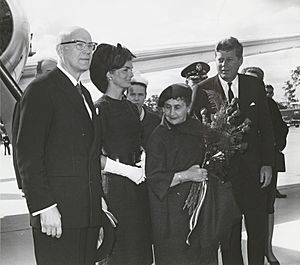

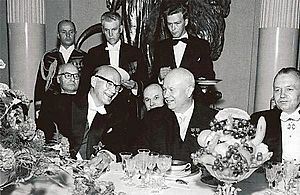
In the 1956 presidential election, Kekkonen won by a very small margin. He beat Karl-August Fagerholm by 151 votes to 149. The election campaign was very tough.
As president, Kekkonen continued the neutrality policy of President Juho Kusti Paasikivi. This policy became known as the Paasikivi–Kekkonen doctrine. He believed he was the only Finnish President the Soviet Union would accept. Records show that the Soviet Union did want Kekkonen to stay in power.
In August 1958, a new government was formed. It included Kekkonen's party, the Agrarian League, but left out the Communist party. This made the Soviet Union unhappy. They didn't like some of the anti-Communist ministers in the government. This led to a problem called the Night Frost Crisis. The Soviet Union put economic pressure on Finland. Kekkonen supported the Soviet Union's view and worked against the government. The government then resigned in December 1958. Kekkonen solved the crisis in January 1959 by traveling to Moscow to talk with Soviet leaders. After this, Kekkonen was seen as the main person who decided which parties could be in the government.
The Soviet Union helped Kekkonen again in 1961 during the Note Crisis. Many people believe the Soviet Union acted to help Kekkonen get re-elected. Other parties tried to form an alliance against Kekkonen. But in October 1961, the Soviet Union sent a diplomatic note. It asked for military exercises with Finland against the West. This was based on the Finno-Soviet Treaty. Because of this, Kekkonen's main opponent dropped out of the election. This left Kekkonen with a clear win in the 1962 elections. After this crisis, there was little real opposition to Kekkonen. He became a very strong leader in Finland.
Some people, like Veikko Vennamo, criticized Kekkonen's policies, especially towards the Soviet Union. Vennamo left Kekkonen's party and formed a new one in 1959.
Later Terms (1962–1978)
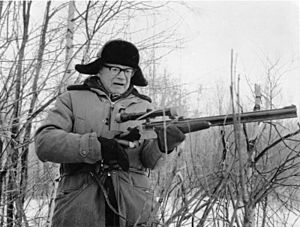

In the 1960s, Kekkonen started several foreign policy plans. These included suggesting a nuclear-free zone for the Nordic countries. He also worked on a border agreement with Norway. In 1969, he proposed a Conference on Security and Cooperation in Europe. These plans aimed to avoid using the military parts of the Finno-Soviet Treaty. Kekkonen wanted to make Finland's neutrality stronger. After the Soviet invasion of Czechoslovakia in 1968, the need for neutrality became even more important. In 1970, Kekkonen told the Soviet Union that if they didn't respect Finland's neutrality, he would not continue as president. He also said the Finno-Soviet Treaty would not be extended.
Kekkonen was re-elected for his third term in 1968. He was supported by many parties. He won with two-thirds of the votes. However, he was unhappy with his opponents' behavior. He said he would not run for president again. He was especially angry at Veikko Vennamo's constant criticisms.
Kekkonen had planned to retire after this term. But he changed his mind. He started to see his possible successor, Ahti Karjalainen, as a rival.
Extending His Term (1973)
| Exceptive law | |
|---|---|
| Parliament of Finland | |
| Act extending the current term of office of the President of the Republic | |
| Citation | Säädöskokoelma 232/1973 |
| Legislative history | |
| Bill citation | HE 247/1972 |
| Third reading | 18 January 1973 |
| Related legislation | |
| Constitution of Finland | |
| Status: Spent | |
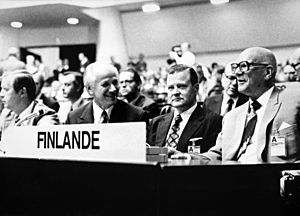
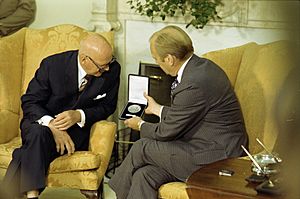
On 18 January 1973, the Finnish Parliament extended Kekkonen's presidential term by four years. This was done with a special law. By this time, most political parties supported Kekkonen. Finland was also negotiating a free-trade agreement with the EEC. This deal was very important for Finnish businesses. Kekkonen suggested that only he could make sure the Soviet Union would accept the deal. This helped him get the support he needed for the special law to pass. With little opposition, he became Finland's very strong political leader. His power was at its highest in 1975. That year, he dissolved parliament and hosted the Conference on Security and Co-operation in Europe (CSCE) in Helsinki.
Final Term (1978–1982)
In the 1978 presidential election, nine political parties supported Kekkonen. There were no serious opponents left. He won a huge victory, getting 259 out of 300 votes. His closest rival received only 25 votes.
Historians say there were a few reasons why Kekkonen stayed president for so long. First, he didn't think anyone else could manage Finland's relationship with the Soviet Union as well as he could. Second, he believed he could still improve relations with the Soviet Union. For example, he used his diplomatic skills to refuse a Soviet offer for joint military exercises. Third, he thought that by working, he would stay healthy and live longer. Some critics said he stayed president mainly because he and his friends wanted to keep their power. In 1980, Kekkonen received the Lenin Peace Prize.
Later Life and Retirement
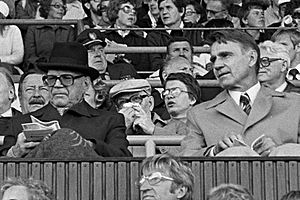
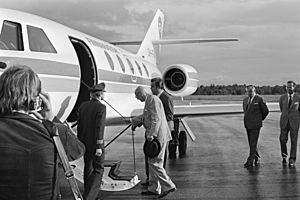
From December 1980, Kekkonen suffered from an illness that affected his brain. He started having memory problems in the 1970s, which became more frequent. His eyesight also got worse. He had other health issues too, like headaches and diabetes. Rumors about his health began in the mid-1970s, but the media tried to keep them quiet.
According to his biographer, Juhani Suomi, Kekkonen didn't think about resigning until his health got worse in July 1981. He then started to seriously consider leaving office. In April 1981, Prime Minister Mauno Koivisto challenged Kekkonen. Koivisto said that the prime minister and government were responsible to Parliament, not to the President. Kekkonen asked Koivisto to resign, but Koivisto refused. This event is seen as the end of Kekkonen's strong hold on power. Kekkonen felt he had lost some of his authority and never fully recovered.
Kekkonen became very ill in August 1981 during a fishing trip. He took medical leave on 10 September. He finally resigned on 26 October 1981, at the age of 81, because of his health. The exact details of his illness are not public. Many believe he suffered from a type of vascular dementia.
Kekkonen stayed out of politics in his final years. He died at Tamminiemi on August 31, 1986, just before his 86th birthday. He was buried with full honors.
Kekkonen's Impact on Finland
Some of Kekkonen's actions are still discussed in Finland today. People have different ideas about how to understand his policies. He often used his good relationship with the Soviet Union when his power was challenged. But he was not the only Finnish politician who had close ties with Soviet officials. Kekkonen's strong leadership during his presidency was one of the main reasons for changes to the Finnish Constitution between 1984 and 2003. These changes gave more power to Parliament and the prime minister, and less to the president. Several of these changes were started by the presidents who came after Kekkonen.
- The president's time in office was limited to two terms.
- The president's role in forming the government was reduced.
- The president would be elected directly by the people, not by an electoral college.
- The president could no longer dissolve Parliament without the prime minister's support.
- The prime minister's role in foreign relations was increased.
Even though his leadership style was debated, his policy of neutrality was very important. It allowed Finland to trade with both the Communist and Western countries. Trading with the Soviet Union was very profitable for many Finnish businesses. During his time, Finland had strong economic growth. It also became more connected with Western countries. He helped Finland join the EFTA. This was an early step for Finland to become part of European integration. Later, Finland joined the EU and started using the euro. He remained very popular during his time as president. He is still popular among many people who lived during his presidency, especially in his own Centre Party.
Tributes to Urho Kekkonen
- The Urho Kekkonen National Park, Finland's second largest national park, is named after him.
- The Urho Kekkonen museum opened in Tamminiemi in 1987.
- In Helsinki, a street was renamed Urho Kekkosen katu (Urho Kekkonen Street) in 1980.
- In Tampere, a road is named the Paasikivi–Kekkonen Road after both Kekkonen and J. K. Paasikivi.
- Kekkonen's picture appeared on the Finnish 500 Mk. banknote while he was still president. This is rare for a living non-royal leader. This banknote was voted Finland's most beautiful note in 2011.
- President Kekkonen is the only Finnish person to have a special collector coin made in his honor while he was alive.
- A silver coin was made in 1981 to celebrate his 25 years as president and his 80th birthday.
- Another silver coin was made on his 75th birthday in 1975. It shows four tall pine trees, symbolizing his first four terms as president.
- Posti Group (Finland's postal service) has issued four postage stamps to honor President Kekkonen.
- 60th birthday stamp (1960)
- 70th birthday stamp (1970)
- 80th birthday stamp (1980)
- Mourning stamp after his death (1986)
- A monument to Urho Kekkonen and Alexei Kosygin was built in Kostomuksha, Russia, in 2013.
- A pub in Etu-Töölö, Helsinki, was named St. Urho's Pub because Kekkonen often visited it.
Images for kids
-
President Kekkonen and his wife Sylvi in Mälkiä, Lappeenranta in 1961
See also
 In Spanish: Urho Kekkonen para niños
In Spanish: Urho Kekkonen para niños
- List of state visits made by President Urho Kekkonen of Finland
- Paasikivi–Kekkonen doctrine
- Georg C. Ehrnrooth
Honours
| Coat of Arms of Urho Kekkonen | |
|---|---|
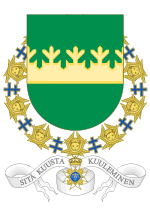 |
|
| Armiger | Urho Kekkonen |
| Adopted | 1956 |
| Motto | "Sitä kuusta kuuleminen" ("Listen to the tree, by the roots of which you live") |
National honours
 Finland: Grand Cross of the Order of the White Rose
Finland: Grand Cross of the Order of the White Rose Finland: Grand Cross of the Order of the Lion of Finland
Finland: Grand Cross of the Order of the Lion of Finland Finland: Grand Cross of the Order of the Cross of Liberty
Finland: Grand Cross of the Order of the Cross of Liberty
Foreign honours
 Sweden: Knight of the Order of the Seraphim
Sweden: Knight of the Order of the Seraphim Norway: Grand Cross of the Order of St. Olav
Norway: Grand Cross of the Order of St. Olav Denmark: Knight of the Order of the Elephant
Denmark: Knight of the Order of the Elephant Iceland: Grand Cross with Collar of the Order of the Falcon
Iceland: Grand Cross with Collar of the Order of the Falcon Austria: Decoration of Honour for Services to the Republic of Austria
Austria: Decoration of Honour for Services to the Republic of Austria United Kingdom: Grand Cross of the Order of the Bath (1969)
United Kingdom: Grand Cross of the Order of the Bath (1969) Italy: Knight Grand Cross with Collar of the Order of Merit of the Italian Republic (1960)
Italy: Knight Grand Cross with Collar of the Order of Merit of the Italian Republic (1960) Spain: Collar of the Order of Isabella the Catholic
Spain: Collar of the Order of Isabella the Catholic Spain: Collar of the Order of Charles III
Spain: Collar of the Order of Charles III Mexico: Collar of the Order of the Aztec Eagle (1963)
Mexico: Collar of the Order of the Aztec Eagle (1963) Tunisia: Grand Cross of the Order of Independence (1965)
Tunisia: Grand Cross of the Order of Independence (1965) Egypt: Collar of the Order of the Nile (1967)
Egypt: Collar of the Order of the Nile (1967) Holy See: Collar of the Order of Pope Pius IX (1971)
Holy See: Collar of the Order of Pope Pius IX (1971) San Marino: Grand Cross with Collar of the Order of San Marino (1971)
San Marino: Grand Cross with Collar of the Order of San Marino (1971) Senegal: Grand Cross of the National Order of the Lion (1973)
Senegal: Grand Cross of the National Order of the Lion (1973) Colombia: Grand Cross of the Order of Boyaca (1980)
Colombia: Grand Cross of the Order of Boyaca (1980) Czechoslovakia: Order of the White Lion (1969)
Czechoslovakia: Order of the White Lion (1969) Soviet Union: Order of Friendship of Peoples
Soviet Union: Order of Friendship of Peoples Soviet Union: Order of Lenin
Soviet Union: Order of Lenin Yugoslavia: Great Star of the Order of the Yugoslav Star (1963)
Yugoslavia: Great Star of the Order of the Yugoslav Star (1963) Iran: Empire of Iran: Grand Cross with Collar of the Order of Pahlavi (1970)
Iran: Empire of Iran: Grand Cross with Collar of the Order of Pahlavi (1970) Iran: Empire of Iran: Commemorative Medal of the 2500th Anniversary of the founding of the Persian Empire (14 October 1971).
Iran: Empire of Iran: Commemorative Medal of the 2500th Anniversary of the founding of the Persian Empire (14 October 1971).



